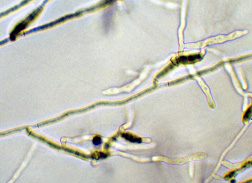This page has been archived and is being provided for reference purposes only. The page is no longer being updated, and therefore, links on the page may be invalid.
|
Read the magazine story to find out more. |
|
|
Evaluating a Natural Fumigant for Apple Orchards
By Jan SuszkiwApril 12, 2006
Apple growers seeking to use natural substances produced by decomposing Brassica plants to "biofumigate" their orchards may want to first consider new findings by Agricultural Research Service (ARS) scientists in Wenatchee, Wash.
Rapeseed, mustard and other Brassica species are gaining popularity in Washington and California as a natural means of controlling soilborne pests before planting time. That's because they release a variety of chemical byproducts upon decomposing--particularly isothiocynates. But according to Mark Mazzola, mechanisms other than biofumigation are at work against Rhizoctonia solani, a fungal culprit behind apple replant disease. Mazzola is a plant pathologist with ARS' Tree Fruit Research Laboratory in Wenatchee.
Mazzola and collaborators want to improve the use of Brassicas in integrated approaches to managing replant disease, which is traditionally fought with chemical fumigants. In the Pacific Northwest, this growth-sapping affliction of young apple trees can cause diminished crop returns up to $40,000 per acre over 10 years.
In trials using ground-up rapeseed as a soil amendment, Mazzola observed that release of isothiocynates had nothing to do with Rhizoctonia control. Rather, the control stemmed from changes the rapeseed caused to the soil environment and microbes living there. Some flourished, while others perished.
For example, Pythium fungi -- another replant disease culprit -- and Streptomyces bacteria strains that produce nitric oxide both thrived. In plants, nitric oxide is an important signaling compound that musters a pest-fighting response called systemic acquired resistance. Mazzola theorizes that Streptomyces increases resulting from rapeseed amendments stimulated this resistance response in apple tree roots, suppressing Rhizoctonia survival long after the isothiocynates had disappeared from the soil.
However, Pythium increases required chemical control with mefenoxam. Thus, Brassica's pest control effectiveness isn't so clear-cut, according to Mazzola, whose studies appear in the journal Plant Disease.
Read more about the research in the April 2006 issue of Agricultural Research magazine.
ARS is the U.S. Department of Agriculture's chief scientific research agency.

